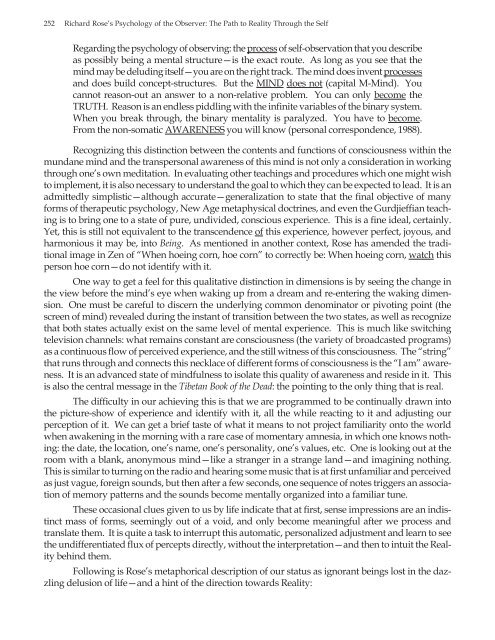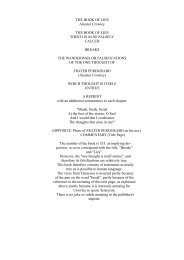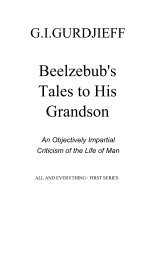Richard Rose’s Psychology of the Observer The Path to Reality Through the Self
John-Kent-Richard-Rose's-Psychology-of-Observer-Path-to-Reality-Thru-the-Self
John-Kent-Richard-Rose's-Psychology-of-Observer-Path-to-Reality-Thru-the-Self
You also want an ePaper? Increase the reach of your titles
YUMPU automatically turns print PDFs into web optimized ePapers that Google loves.
252 <strong>Richard</strong> <strong>Rose’s</strong> <strong>Psychology</strong> <strong>of</strong> <strong>the</strong> <strong>Observer</strong>: <strong>The</strong> <strong>Path</strong> <strong>to</strong> <strong>Reality</strong> <strong>Through</strong> <strong>the</strong> <strong>Self</strong><br />
Regarding <strong>the</strong> psychology <strong>of</strong> observing: <strong>the</strong> process <strong>of</strong> self-observation that you describe<br />
as possibly being a mental structure—is <strong>the</strong> exact route. As long as you see that <strong>the</strong><br />
mind may be deluding itself—you are on <strong>the</strong> right track. <strong>The</strong> mind does invent processes<br />
and does build concept-structures. But <strong>the</strong> MIND does not (capital M-Mind). You<br />
cannot reason-out an answer <strong>to</strong> a non-relative problem. You can only become <strong>the</strong><br />
TRUTH. Reason is an endless piddling with <strong>the</strong> infinite variables <strong>of</strong> <strong>the</strong> binary system.<br />
When you break through, <strong>the</strong> binary mentality is paralyzed. You have <strong>to</strong> become.<br />
From <strong>the</strong> non-somatic AWARENESS you will know (personal correspondence, 1988).<br />
Recognizing this distinction between <strong>the</strong> contents and functions <strong>of</strong> consciousness within <strong>the</strong><br />
mundane mind and <strong>the</strong> transpersonal awareness <strong>of</strong> this mind is not only a consideration in working<br />
through one’s own meditation. In evaluating o<strong>the</strong>r teachings and procedures which one might wish<br />
<strong>to</strong> implement, it is also necessary <strong>to</strong> understand <strong>the</strong> goal <strong>to</strong> which <strong>the</strong>y can be expected <strong>to</strong> lead. It is an<br />
admittedly simplistic—although accurate—generalization <strong>to</strong> state that <strong>the</strong> final objective <strong>of</strong> many<br />
forms <strong>of</strong> <strong>the</strong>rapeutic psychology, New Age metaphysical doctrines, and even <strong>the</strong> Gurdjieffian teaching<br />
is <strong>to</strong> bring one <strong>to</strong> a state <strong>of</strong> pure, undivided, conscious experience. This is a fine ideal, certainly.<br />
Yet, this is still not equivalent <strong>to</strong> <strong>the</strong> transcendence <strong>of</strong> this experience, however perfect, joyous, and<br />
harmonious it may be, in<strong>to</strong> Being. As mentioned in ano<strong>the</strong>r context, Rose has amended <strong>the</strong> traditional<br />
image in Zen <strong>of</strong> “When hoeing corn, hoe corn” <strong>to</strong> correctly be: When hoeing corn, watch this<br />
person hoe corn—do not identify with it.<br />
One way <strong>to</strong> get a feel for this qualitative distinction in dimensions is by seeing <strong>the</strong> change in<br />
<strong>the</strong> view before <strong>the</strong> mind’s eye when waking up from a dream and re-entering <strong>the</strong> waking dimension.<br />
One must be careful <strong>to</strong> discern <strong>the</strong> underlying common denomina<strong>to</strong>r or pivoting point (<strong>the</strong><br />
screen <strong>of</strong> mind) revealed during <strong>the</strong> instant <strong>of</strong> transition between <strong>the</strong> two states, as well as recognize<br />
that both states actually exist on <strong>the</strong> same level <strong>of</strong> mental experience. This is much like switching<br />
television channels: what remains constant are consciousness (<strong>the</strong> variety <strong>of</strong> broadcasted programs)<br />
as a continuous flow <strong>of</strong> perceived experience, and <strong>the</strong> still witness <strong>of</strong> this consciousness. <strong>The</strong> “string”<br />
that runs through and connects this necklace <strong>of</strong> different forms <strong>of</strong> consciousness is <strong>the</strong> “I am” awareness.<br />
It is an advanced state <strong>of</strong> mindfulness <strong>to</strong> isolate this quality <strong>of</strong> awareness and reside in it. This<br />
is also <strong>the</strong> central message in <strong>the</strong> Tibetan Book <strong>of</strong> <strong>the</strong> Dead: <strong>the</strong> pointing <strong>to</strong> <strong>the</strong> only thing that is real.<br />
<strong>The</strong> difficulty in our achieving this is that we are programmed <strong>to</strong> be continually drawn in<strong>to</strong><br />
<strong>the</strong> picture-show <strong>of</strong> experience and identify with it, all <strong>the</strong> while reacting <strong>to</strong> it and adjusting our<br />
perception <strong>of</strong> it. We can get a brief taste <strong>of</strong> what it means <strong>to</strong> not project familiarity on<strong>to</strong> <strong>the</strong> world<br />
when awakening in <strong>the</strong> morning with a rare case <strong>of</strong> momentary amnesia, in which one knows nothing:<br />
<strong>the</strong> date, <strong>the</strong> location, one’s name, one’s personality, one’s values, etc. One is looking out at <strong>the</strong><br />
room with a blank, anonymous mind—like a stranger in a strange land—and imagining nothing.<br />
This is similar <strong>to</strong> turning on <strong>the</strong> radio and hearing some music that is at first unfamiliar and perceived<br />
as just vague, foreign sounds, but <strong>the</strong>n after a few seconds, one sequence <strong>of</strong> notes triggers an association<br />
<strong>of</strong> memory patterns and <strong>the</strong> sounds become mentally organized in<strong>to</strong> a familiar tune.<br />
<strong>The</strong>se occasional clues given <strong>to</strong> us by life indicate that at first, sense impressions are an indistinct<br />
mass <strong>of</strong> forms, seemingly out <strong>of</strong> a void, and only become meaningful after we process and<br />
translate <strong>the</strong>m. It is quite a task <strong>to</strong> interrupt this au<strong>to</strong>matic, personalized adjustment and learn <strong>to</strong> see<br />
<strong>the</strong> undifferentiated flux <strong>of</strong> percepts directly, without <strong>the</strong> interpretation—and <strong>the</strong>n <strong>to</strong> intuit <strong>the</strong> <strong>Reality</strong><br />
behind <strong>the</strong>m.<br />
Following is <strong>Rose’s</strong> metaphorical description <strong>of</strong> our status as ignorant beings lost in <strong>the</strong> dazzling<br />
delusion <strong>of</strong> life—and a hint <strong>of</strong> <strong>the</strong> direction <strong>to</strong>wards <strong>Reality</strong>:




